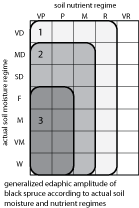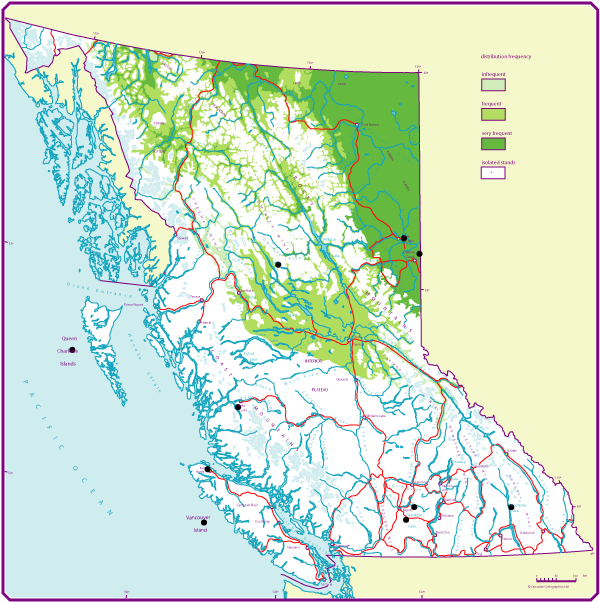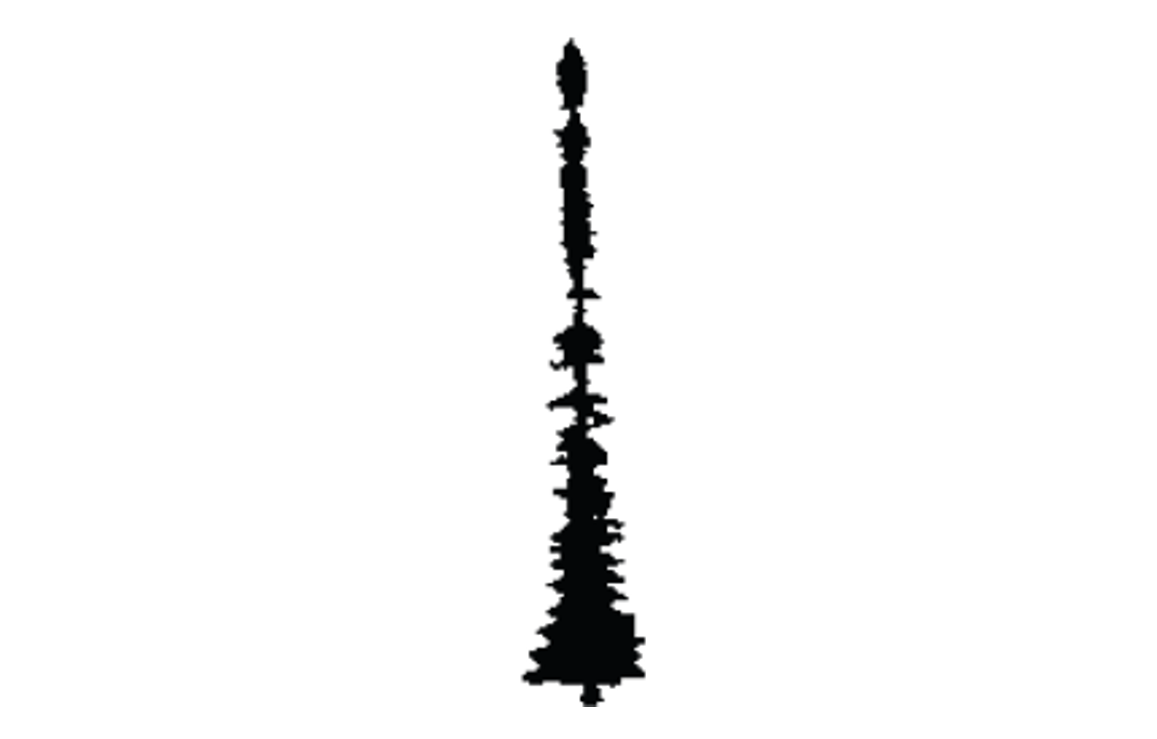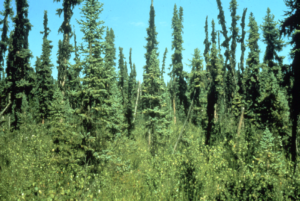Black spruce
On this page
- Geographic range and ecological amplitudes
- Tolerances and damaging agents
- Silvical characteristics
- Genetics and notes
Geographic range and ecological amplitudes
Description
At maturity, black spruce is a small- to medium-sized (exceptionally >30m tall), evergreen conifer, with a narrow, compact, conical crown, which may develop a characteristic club-like shape, and grayish-brown, thin, scaly bark. The wood of black spruce is used for making high quality pulp with balanced strength properties.
Geographic range
Geographic element:
North American transcontinental-incomplete
Distribution in Western North America:
(north) in the Pacific region; north and central in the Cordilleran region
Ecological amplitudes
Climatic amplitude:
subarctic – subalpine boreal – montane boreal – (cool temperate)
Orographic amplitude:
submontane – montane – subalpine
Occurrence in biogeoclimatic zones:
SWB, BWBS, SBS, (SBPS), (northern IDF), (northern ICH)
Edaphic amplitude

Range of soil moisture regimes:
(very dry) – moderately dry – slightly dry – fresh – moist – very moist – wet – very wet
Range of soil nutrient regimes:
very poor – poor – medium – (rich); oxylophytic
The most productive growth of black spruce occurs on moist and medium sites; therefore, it could be concluded that black spruce does not tolerate as high a supply of calcium and magnesium as does white or Engelmann spruce. The stunted growth and krummholz form on limestone – and dolomite-derived soils, where white spruce grows very well, indicates that high levels of calcium, magnesium, and nitrate-nitrogen adversely affect black spruce growth.
Black spruce tolerates very acid substrates. For example, in circumneutral or even alkaline swamps, where tamarack or white spruce are primary species, black spruce grows only on acidic decaying coniferous wood.
Tolerances and damaging agents
Root system characteristics
Although some black spruce roots may penetrate to the depth of 60cm, most spread laterally at the moss-forest floor interface. The bulk of the root biomass is in the upper 20cm of organic horizon. Roots of black spruce are associated with both ecto – and endo-mycorrhizae.
| Tolerance to | Tolerance class | Comments |
|---|---|---|
| low light | H | more shade-tolerant than the other spruce species |
| frost | H | withstands severe winter temperature and permafrost soils |
| heat | M | infrequent on insolated sites |
| water deficit | M | infrequent on very dry sites |
| water surplus | H | abundant on waterlogged sites; less tolerant of prolonged flooding |
| nutrient (mainly N) deficiency | H | oxylophyte; common on acid substrates and very poor sites |
| Damaging agent | Resistance class | Comments |
|---|---|---|
| snow | H | due to very narrow, shedding crown and stringy branches |
| wind | L | prone to windthrow, especially in mature stands |
| Risk class | ||
|---|---|---|
| fire | H | high on upland sites, not a concern in wetlands |
| insect | M | spruce budworm, white pine weevil |
| fungi | L | not a major concern; root and butt rots (Armillaria root disease, tomentosus root rot, and red ring rot) |
Associated tree species and successional role
In British Columbia, black spruce usually grows in pure stands, especially on wet and very wet, very poor and poor sites. This is more particularly the case in Quebec, where rich soils are rare. Black spruce is a pioneer species (primary succession) in ombotrophic wetlands and present in early, mid-, and late stages of secondary succession; a variable component in old-growth stands in the SWB, BWBS, and SBS zones.
| Associated tree species |
Occurance class | Major area of occurance |
|---|---|---|
| lodgepole pine | H | The most commonly associated species in BWBS |
| white spruce (and hybrids) | H | SWB and BWBS |
| tamarack | M | BWBS |
| balsam poplar and Black cottonwood | L | BWBS |
| trembling aspen | L | BWBS |
| paper birch | L | BWBS |
| subalpine fir | L | BWBS; usually in old-growth stands |
Genetics and notes
Genetics
Genetic variation in black spruce is clinal, primarily along a latitudinal gradient. The hybrids between black and white spruces (see Picea glauca) are no where near as frequent as hybrids between white and Engelmann spruces.
Notes
Black spruce is a desirable component in pure or mixed-species stands, either with other conifers, such as lodgepole pine or white spruce, or hardwoods, such as trembling aspen, in northern, montane boreal forests. Black spruce regenerates naturally following fire disturbance or can be planted if it was a minor component in the original stand. More detailed silvics information is given by:
Viereck, L.A. and W.F. Johnston. 1990. Picea mariana. Pp. 227-237 in R.M. Burns and B.H. Honkala (technical coordinators) Silvics of North America, Vol. 1. Agri. Handbook 654, USDA For. Serv., Washington, D.C.



